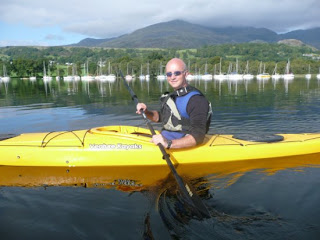We were staying at the little coastal village of Beg Meil in south west Brittany, France, a short walk from the beach. The Atlantic breakers make for some interesting kayaking - but just round the headland is the relative shelter of the Bay of Concarneau.
One of the places we wanted to explore was the resort of Cap Coz, about a four mile (six kilometre) paddle across the bay. Cap Coz is popular for sailing and water sports and has a long white sandy beach. Un bon endroit pour faire du kayak!
Round the headland
We waited for a day with light winds and picked our moment to easily paddle through the surf on the sandy beach at Beg Meil. We quickly reached the headland and went out to sea to give it a wide berth, as the waves were crashing on it dramatically and there were big jagged rocks sticking out of the water.
It should have been an easy paddle but we were head to the wind, which had picked up again, making it a tiring effort to stay on course. It was a bright sunny day, however, and we could see the sheltered bay ahead of us.
Across the bay to Cap Coz
The conditions were completely different in the bay, which is a couple of miles across and has boat moorings dotted all over. We could just about make out Cap Coz in the distance as it had little dinghys with brightly coloured sails on the beach.
We arrived at the gently sloping white sandy beach, an ideal location for anyone new to kayaking in Brittany, as it had good facilities and is within eacy reach of the historic fishing port of Concarneau, with its walled city and ancient harbour.
Back through the breakers
After spending the afternoon at Cap Coz we headed back across the bay and realised that the sea was really picking up. We had thought it was a bit rough around the headland before but now it was a real battle just to get round.
Once we were pointing towards the beach at Beg Meil, it was all a matter of timing. The beach had been deserted when we left but was quite busy by that time, so we had plenty of spectators to watch us surf the breakers, paddling really fast to stay on line and returning dramatically through the breakers – fortunately without wiping out at the last moment! B
on amusement!
 |
| Rounding the headland at Beg Meil |
 |
Cap Coz in Brittany
|













